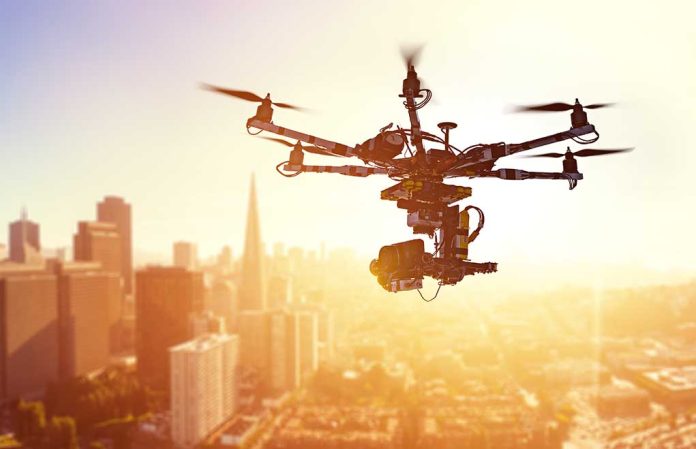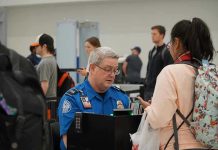
Russian military official Sergei Tokarev accidentally killed himself with his own gun after panicking during a massive Ukrainian drone attack on Crimea, highlighting the psychological impact of Ukraine’s increasingly bold strikes against Russian-held territory.
Key Takeaways
- Sergei Tokarev, head of the military medical commission of Sevastopol’s Ministry of Internal Affairs, died after accidentally shooting himself during a Ukrainian drone attack on Crimea
- Ukraine launched a massive drone campaign targeting multiple Russian military airfields and infrastructure in occupied Crimea
- Russian defense officials claimed to have intercepted 89 Ukrainian drones over Crimea and 23 over the Black Sea
- Strategic Russian military airfields in Sevastopol, Dzhankoy, Saky, Novofedorivka, and Kacha were targeted, with videos showing explosions and fires
- The drone campaign has disrupted Russian civil aviation, with 60,000 passengers stranded and 350 flights affected across major Russian cities
Fatal Panic During Crimean Drone Barrage
The escalating Ukrainian drone offensive against Russian-occupied Crimea claimed an unexpected casualty when Sergei Tokarev, a high-ranking Russian military official, accidentally shot himself after becoming disoriented during an air raid. According to reports from the Astra Telegram channel, Tokarev, who served as head of the military medical commission of the Ministry of Internal Affairs in Sevastopol, armed himself with a pistol during the attack and fatally shot himself in the head while attempting to respond to the threat.
“The head of the military medical commission of Sevastopol’s Ministry of Internal Affairs died after accidentally shooting himself in the head during a massive drone attack,” reported the Astra Telegram channel.
The bizarre incident prompted Kyiv-based journalist Dennis Kazansky to remark on social media: “This is the most unexpected effects of a drone I have ever heard about.” The fatal accident underscores the psychological impact of Ukraine’s relentless drone campaign, which has successfully penetrated deep into Russian-held territory despite Moscow’s claims of effective air defenses.
Strategic Strikes Across Crimea
Ukraine’s coordinated drone assault targeted numerous military installations across the peninsula, focusing on airfields that serve as crucial launching points for Russian operations in the Black Sea region. Russian officials claimed to have intercepted 89 Ukrainian drones over Crimea and 23 over the Black Sea, but satellite imagery and witness accounts confirmed successful strikes on key infrastructure. Explosions were reported near Russian military airfields in Sevastopol, Dzhankoy, Saky, Novofedorivka, and Kacha.
The Saky and Kacha airfields are particularly valuable to Russia’s military infrastructure, serving as essential bases for controlling the Black Sea and launching air operations against Ukrainian territory. Videos circulated online showing multiple explosions and a significant fire near the village of Uhlove, in close proximity to the Kacha airfield. These strategic sites have been repeatedly targeted by Ukrainian forces, who aim to degrade Russia’s ability to project military power from the illegally annexed peninsula.
Russian Aviation Chaos and Failed Ceasefire
The wave of Ukrainian drone attacks has had far-reaching consequences beyond military targets, causing massive disruptions to Russian civilian air traffic. Reports indicate at least 60,000 passengers were stranded at Russian airports after the attacks forced the closure of multiple facilities. Around 350 flights were affected in Moscow, St. Petersburg, Sochi, and other major cities as Russian authorities implemented emergency aviation protocols to address the threat of Ukrainian drones in their airspace.
“We think they [Russians] are asking for too much,” said US Vice-President JD Vance, commenting on Russia’s proposed three-day ceasefire ahead of their World War Two victory parade.
The timing of Ukraine’s offensive coincides with President Trump’s renewed efforts to bring the parties to the negotiating table. While Russia had proposed a limited three-day ceasefire to coincide with its May 9 military parade, Ukraine and its allies have demanded a more substantial 30-day halt to hostilities. Vice President Vance has emphasized the importance of direct dialogue between the warring parties, stating: “It’s very important for the Russians and the Ukrainians to start talking to one another.”
Moscow’s Propaganda Parade Under Threat
Despite the significant Ukrainian drone offensive, Moscow proceeded with preparations for its annual Victory Day parade commemorating the Soviet triumph over Nazi Germany in World War II. Chinese President Xi Jinping arrived in Moscow for the event, along with leaders from Brazil, Venezuela, and approximately two dozen other nations sympathetic to Russia. However, the drone attacks cast a shadow over the propagandistic display of Russian military might, forcing heightened security measures.
“The fleet, in cooperation with air defense forces, is reflecting a massive combined attack,” admitted Mikhail Razvozhayev, the Russian-installed leader in Sevastopol, while attempting to downplay any damage to infrastructure.
The Russian defense ministry made the extraordinary claim of destroying 524 Ukrainian drones in a 24-hour period, a figure that analysts view with considerable skepticism given Russia’s documented struggles with drone defense. Some European nations, including the Baltic states and Estonia, have refused airspace access for certain flights to Moscow in a show of solidarity with Ukraine and opposition to Russia’s propaganda event celebrating its military while it continues its illegal occupation of Ukrainian territory.













